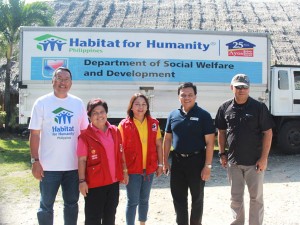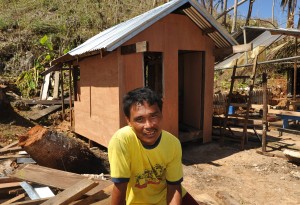
The Habitat Mobile Emergency Response (HaMER) with DSWD Sec. Dinky Soliman and Habitat for Humanity Philippines (HFHP) Managing Director & CEO Charlie Ayco. MIKEL FLAMM
Due to extensive damage and lack of funding, agencies tasked to rebuild houses for the affected families of Supertyphoon “Yolanda” (international name Haiyan) face severe lack of shelter materials to address the massive needs. Shelter agency Habitat for Humanity Philippines said the shortfall in roofing and framing materials, unless donors quickly provide the necessary funding and material support, will force the thousands of homeless families in Central Visayas to stay in evacuation centers at least until the first quarter of 2014.
“Yolanda has destroyed and severely damaged more than 1 million houses or displaced over 4 million people. In some communities, all houses were destroyed,” Charlie Ayco, Chief Executive Officer of Habitat for Humanity Philippines, said. “Under the Haiyan (Yolanda) Action Plan, shelter agencies are asking for USD 46 million in funding. But so far, only USD 16 million or 36% have been pledged,” he added.
Due to the lack of funding, shelter agencies like Habitat are predicting a severe shortfall in roofing and framing materials like the more than four million sheets of corrugated iron sheeting (CGI) that are needed. They also estimate that even with funding, it will take until February 2014 to provide the affected people with the most basic emergency shelter items like tarpaulins and other materials for roofing and storm straps.
“Can you imagine the number of families who will be in evacuation centers this Christmas, New Year, and even up to Valentine’s Day? They are resilient but aside from losing homes, they also lost all their assets and possessions. How can they rebuild their lives if they will stay in the evacuation centers?” Ayco added.
According to Ayco, Habitat aims to build 30,000 core shelters, or basic 20-square meter houses, in the most affected communities of the super typhoon. The houses are designed to withstand 275 kilometers per hour winds and earthquakes but will cost only around Php 200,000 each. He said Habitat uses various ways to bring down the costs through combination of smart and appropriate technology, efficient systems, the use of volunteers and resource leveraging, and its “sweat equity” program, which requires recipient families to help in the construction of their would-be houses by rendering at least 100 hours of service.
Habitat had previously constructed in impressive time 6,000 core houses in Cagayan de Oro City for the survivors of Typhoon “Sendong” (international name Bopha) in 2011. It is also

A grateful Anthony Illustrisimo of Panangatan, Bantyan, Cebu, after receiving his emergency shelter kits. Over 1,400 Shelter Repair Kits (SRK) were distributed in Daanbantayan, Cebu in partnership with Lutheran World Relief. MIKEL FLAMM
currently assisting in the building of houses for the displaced families of the recent Zamboanga conflict and the 7.2 magnitude earthquake in Bohol last October 15, 2013.
“Debris needs to be removed quickly, so we are also providing cleaning kits. We also distribute shelter repair kits and teach people to salvage building materials and repair their damaged houses,” Ayco said.
“The affected people have already started to rebuild their lives. Shelter agencies like Habitat want to support them and so I’m appealing to everyone to help. It will take years, unless everyone and every sector, pitch in,” he said.
Habitat is raising funds to build 30,000 core houses for the Yolanda survivors. It’s campaign name is a call to action “Give the Gift of Home this Christmas!” A donation of Php 400,000 (USD 4,700) enables Habitat to build one core house, Php 15,000 (USD 350) to repair a damaged house, and Php 2,000 (USD 50) to clean up the debris of a home. Donors may give by giving through to https://www.give2habitat.org/philippines/ReBuildPhilippines. (advt)

